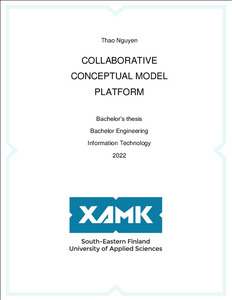Collaborative Conceptual Model Platform
Nguyen, Thao (2022)
Nguyen, Thao
2022
All rights reserved. This publication is copyrighted. You may download, display and print it for Your own personal use. Commercial use is prohibited.
Julkaisun pysyvä osoite on
https://urn.fi/URN:NBN:fi:amk-2022060214628
https://urn.fi/URN:NBN:fi:amk-2022060214628
Tiivistelmä
The thesis introduced a collaborative platform where data modelers designed their conceptual models together. Data modeling was becoming a trend for data governance and also due to COVID-19 where people started to work remotely, a software as a service platform that allow multiple data modelers to work in the same model is vital in organizations.
In the theoretical part of this thesis, there were two main topics that were explained. The first topic explained the canvas, specifically what is SVG and conceptual model. The second topic introduced and explained the definition of the services which were used in the practical part of this thesis.
The practical part explained the process of the implementation of the application. There are two main parts, front-end and back-end. The front-end described the most important user interface components of the application. The back-end showed how to create the database and the routes for the application.
After the practical part was completed, the result of the application was discussed. Some considerations and improvements were also discussed. Finally, the conclusion showed how the thesis solved the problem that was introduced, and possible improvement that could be implemented in the future.
In the theoretical part of this thesis, there were two main topics that were explained. The first topic explained the canvas, specifically what is SVG and conceptual model. The second topic introduced and explained the definition of the services which were used in the practical part of this thesis.
The practical part explained the process of the implementation of the application. There are two main parts, front-end and back-end. The front-end described the most important user interface components of the application. The back-end showed how to create the database and the routes for the application.
After the practical part was completed, the result of the application was discussed. Some considerations and improvements were also discussed. Finally, the conclusion showed how the thesis solved the problem that was introduced, and possible improvement that could be implemented in the future.
